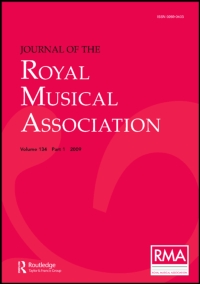No CrossRef data available.
Article contents
The Structure of Plainsong
Published online by Cambridge University Press: 01 January 2020
Extract
It is proposed in this paper to examine briefly into the present state of our knowledge as to the musical structure of Plainsong. Until about twenty years since, when the Benedictine monks of Solesmes began to publish the results of their systematic study of the music, theories on the art were founded mostly on conjecture. The reason for this was that the chant was composed more than two centuries before the earliest and very rudimentary treatise on the subject was written; that the few later works treated of things from a different point of view to ours, so that they are not very easy to understand; and that by the time writers become more in accord with us moderns, say the fifteenth century, the rendering of Plainsong had become so corrupted that all theoretical treatises were completely worthless. Practically, therefore, all that we have to work upon is the music itself, with some vague indications in treatises of about the ninth century, which may or may not be comprehensible, and may often be twisted to mean anything we like. The notation in which the music has come down to us is in four forms—viz., the Alphabetic, the Dasiau, the Neumatic, and the Square notation. The alphabetic is but rarely met with, and was probably only used for instruction books. The Dasian is used in the MSS. formerly attributed to Hucbald, but these only contain a few examples illustrating the treatises. The neumatic was the notation in general use down to the eleventh century, when it was gradually converted into the ordinary square notation. Now this last shows us exactly the notes to be sung, but very little more. If properly printed in the style of all MSS. until the sixteenth century, the phrasing is fairly well indicated, and it acts very serviceably, far better than modern notation, for singers acquainted with the spirit of Plainsong; but by itself it is as useless as “Rule, Britannia,” written in minims would be. But when this square notation is collated with its forerunner, the neumatic, a different state of things appears. The square notation shows only the notes; the neumatic shows none of the notes but almost everything else that converts notes into music. The approximate time value (all that can be given in recitative), the phrasing, the expression, all is given in the neums as clearly as in a modern composition. For example, the podatus only expresses two notes of which the first is lower than the second, but neither the tonal value of the first note nor the interval of the second. But it has four different forms, which must necessarily mean four different renderings of the note-group—i.e., that the first note of the group is accented, but that each note may have a longer or shorter duration according to the form of the neum. And it has even a fifth variety, which I take to be a turn on the first note as indicated by the wavy form given to the lower limb (see neum at end of second line in the Alleluia, p. 70).
- Type
- Research Article
- Information
- Copyright
- Copyright © Royal Musical Association, 1897
References
∗ See further “The Elements of Plainsong” (Vincent) 3s 6d.Google Scholar
∗ “Deprecamur Te” (Vincent) 2d.Google Scholar
∗ “The Ordinary of the Mass” (Vincent). 2s. 6d.Google Scholar
∗ We will speak of b♭ as ♭ and B♮ as ♮.Google Scholar
∗ The numbers refer to “Plainsong Hymn Melodies and Sequences” (Vincent). 2s. 6d.Google Scholar
∗ A fac-simile Gradual published by the Plainsong and Mediæval Music Society (Quaritch). £4.Google Scholar


